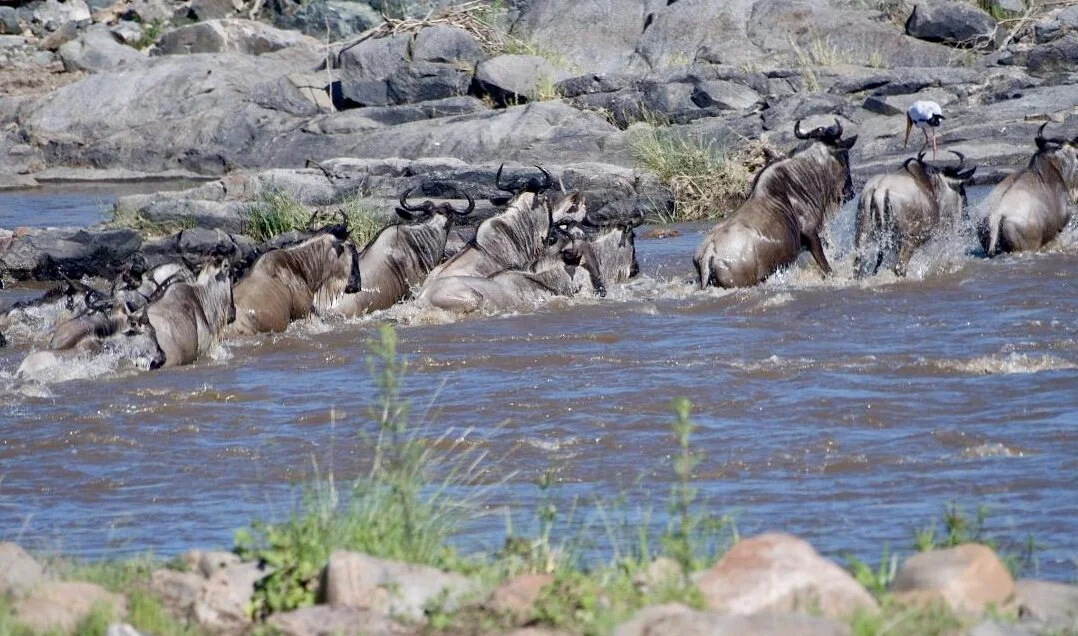WILD TANZANIA - ZANZIBAR 11 Days
This itinerary visits Tarangine National Park, Ngorongoro Conservation, the Serengeti and Zanzibar.
Tanzania is a mountainous, densely forested nation where Mount Kilimanjaro is located. It is home to some of the oldest hominid settlements unearthed by archaeologists. Prehistoric stone tools and fossils have been found in northern Tanzania.
Two (2) of Africa’s Great Lakes are partly within Tanzania’s borders. Lake Victoria-Africa’s largest lake, and Lake Tanganyika-the continent’s deepest lake, known for its unique species of fish.
Most of Tanzania is a large plateau, with plains and arable land. The renowned plains of Serengeti National Park, a safari mecca populated by the “big five” game and the Ngorongoro crater, the world's largest inactive caldera reside here. On the eastern side, lies the Zanzibar Archipelago, home to whale sharks and coral reefs. Tanzania is similar in size to the countries of Colombia and Namibia.
Tips:
When embarking on a safari, which is often considered a once-in-a-lifetime trip for many visitors, it is highly recommended to utilize the services of a tour operator.
Travelwildnow.com strongly suggests opting for a licensed tour operator for your adventure, as they offer numerous benefits and conveniences. To find reliable tour operators, we recommend consulting reputable travel guides such as Lonely Planet, Bradt and Fodors.
A tour operator will handle various aspects of your excursion, including accommodation arrangements, meal provisions, local transportation, specific tours, and professional guides. Additionally, they provide competitive pricing, ensuring you get the best value for your safari experience.
USD is accepted at most tourist destinations. There is no need to exchange to Tanzania currency.
Make sure a quality dust-free bag always protects your camera. You will be driving on unpaved roads, dust easily gets into your jeep and may damage your camera.
The itinerary below will provide a guideline to your adventure.
Before you go:
A tourist Visa is required - Apply Online
Travel Adaptors - Type D and Type G
Consider travel insurance.
Vaccines and malaria medication may be required.
Yellow fever proof of vaccination may be required.
WHAT DOES A TYPICAL SAFARI DAY LOOK LIKE ?
05.30 AM: wake up call by a knock and animal sounds.
06.30 AM: after coffee or tea and a morning snack, start the morning safari with a game drive or boat trip.
09.30 AM: extensive breakfast.
10.00 AM - 2.30 PM: time to relax and have lunch.
02.30 PM: second game activity, either a drive, mokoro, or motorized boat trip.
07.00 PM: back in the lodge for dinner and leisure time.
10.00 PM: bedtime.
DAY 1
Arrive at Kilimanjaro airport and transfer to your accommodations.
Tour operator representative will meet guests at airport.
Overnight: depending on arrival time, either stay in the town of Arusha or at Tarangire National Park.
Drive time:
Kilimanjaro airport ---> Arusha, 1 hour
Kilimanjaro airport ---> Tarangire Park lodge/camp, 4 hrs. / 200 km.
Arusha ---> Tarangire National Park, 3 hrs.
DAY 2
The park is famous for its high density of baobab trees and elephants and for the termite mounds that dot the landscape.
During the months of June to October (dry season) visitors can expect to see large herds of zebra, wildebeest, cape buffalo and other common resident animals.
Games drives are scheduled early morning, afternoon and evening.
Overnight: Tarangire Park <where to stay>
DAY 3
Depart Tarangire to Ngorongoro Crater. It is the world's largest inactive, intact and unfilled volcanic caldera.
The Ngorongoro Conservation Area is a World Heritage Site, located west of Arusha in the Crater Highlands area of Tanzania. The caldera measures 17 km (10 mi.) across. The crater itself is 600 meters (2000 feet) deep to the bottom.
The crater is home to the rare spotted black rhino, together with other wildlife including leopards, hippos, lions and hyenas. What you will NOT FIND is giraffes. The reason is the crater sides are too steep for giraffes to walk down.
The Crater rim provides panoramic views and excellent opportunities for photographers!
Overnight: Ngorongoro Park <where to stay> <Planning + Map>
Drive time: Tarangire ---> Ngorongoro Crater, 5 hrs. / 120 km.
Experience a African Safari !
DAY 4
Morning game drive in the Ngorongoro Crater floor.
The crater floor is a impressive eco-system filled with a diversity of animals.
The Ngorongoro Conservation Area is one of the most important prehistoric sites in the world. The fossils discovered there are said to be the earliest known evidence of the human species.
In the afternoon, embark to Serengeti National Park.
Overnight: Serengeti Park (3 nights) <where to stay>
Drive time:
Ngorongoro Crater ---> Serengeti Park. 3.5 hrs. / 160 km.
DAYS 5 and 6
Two (2) exciting days at Serengeti National Park. <Planning + Map>
The Park is located in the Serengeti ecosystem within the Mara and Simiyu regions. It is here the well-known annual migration of over 1.5-million white-bearded (or brindled) wildebeest, 250,000 zebra and the numerous Nile crocodiles occur.
Lobo Valley (Northern Serengeti): The valley is a frequent spot to catch a glimpse of the famous migration. Starting from July through November, millions of wildebeest, gazelles and zebras congregate to the region during The Great Migration. Plus the Lobo Valley is one of the only places in the park where all three (3) big cats-lions, cheetahs and leopards roam.
Seronera Valley (Central Serengeti): Because of the area's prime wildlife-viewing opportunities, the Seronera River Valley also contains many of the park's permanent lodges. While that's good for those who prefer their excursions with a side of luxury, it's also a drawback for travelers who would rather watch the animals without the band of other tourists.
Morning, afternoon and evening game drives.
Overnight: Serengeti Park.
DAY 7
Depart the Serengeti and transfer to Kogatende Airstrip (North Serengeti) for your flight to Zanzibar.
The small planes (flying out of the Serengeti) usually have total weight restrictions of 15 kg for luggage & carry-on combined.
Make sure you check with your airline. <Learn more>
If you are concerned about the strict luggage regulations imposed by air carriers or have a strong fear of small planes, an alternative option to consider is road travel. However, it's important to be aware that long distances are involved, and the roads can be extremely dusty and bumpy.
For instance, traveling from Serengeti to Arusha airport by road would require a 12-hour drive. Once you reach Arusha airport, you then catch a flight to Zanzibar, providing a seamless transition to your next destination.
Arrive in Zanzibar and transfer to your beachfront hotel and relax rest of the day.
DAYS 8-10. Discover the exotic island of Zanzibar.
The beaches are stunning, consisting of powdery white sand, shaded by palm trees. The sea is shallow and tropical, and the reefs are great for snorkeling and diving.
Along Zanzibar’s eastern coastline runs a protective barrier reef and next is the Indian Ocean. This is where the best beaches are located, with coral white sand and tranquil waters. <Learn More>
Because of its location, barrier reef and outstanding beaches, Zanzibar can offer all of the attractions that most visitors crave such as scuba diving, glorious beaches, fresh seafood.
Visit Stone Town. The heart of Stone Town is made up of a maze of narrow alleys lined by houses, shops, bazaars and mosques. Since most streets are too narrow for cars, the town is crowded with bicycles and motorbikes. Zanzibar is famous for its doors. The best-known feature of the Zanzibar houses are the finely decorated wooden doors, with rich carvings.
Visit the the old slave market, the House of Wonders, Darajani marketplace, the Old Fort and the Sultan’s Palace.
Zanzibar was once of the world’s leading producers of spices such as clove, nutmeg and cinnamon.
Take a Spice Tour if time allows.
The islands in the archipelago are highly fertile, with many agricultural resources. There are small farms and the air smells with the aroma spices.
Where to stay: The East Coast of Zanzibar is arguably the best location for visitors due to its picture-perfect beaches.
Our top choice: Breezes Beach Club and Spa.
Distances:
The island is a fairly undeveloped with only around five (5) main roads.
—Geographically, Zanzibar is only around 40 km (24-mi.) across and 100 km. (60-mi.) from north to south at its widest points.
Stone Town to Breezes Beach Club, 70 min.
—Stone Town to Nungwi, 1.5 hrs.
DAY 11
Depart Zanzibar for your flight home or your next African destination.
Average cost:
(EXCLUDING AIRFARE)
$$$ USD per person:
Budget: $3500
Moderate: $5300
Luxury: $6500 +
When to go on a Tanzania Safari ?
The classic BEST TIME to visit Tanzania for a safari is generally during a four (4)-to-five (5) month window from mid-June to late-October, the peak being around August.
During late-April through September you are most likely to experience GOOD weather with pleasant average temperatures between 20 degrees Celsius (68°F) and 25 degrees Celsius (77°F).
The months February, March, May, November and December have a high chance of precipitation.
The Tanzania northern circuit parks have dry periods June through October.
The warmest months are December through February.
The coolest months are June through August.
Best time to visit Zanzibar:
There are two (2) rainy seasons in Zanzibar.
The main season, called the "long rains" is during mid-April and May.
The second rainy season, "the short rains" is from November to December.
The best times to visit Zanzibar are from June to early-October during the cool, dry months, or January to February when it’s hot and dry.
Source: wikipedi.orgNo copyright infringement is intended on this website by travelwildnow.com











